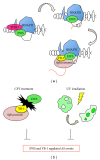Ewing sarcoma protein: a key player in human cancer
- PMID: 24082883
- PMCID: PMC3776376
- DOI: 10.1155/2013/642853
Ewing sarcoma protein: a key player in human cancer
Abstract
The Ewing sarcoma protein (EWS) is a well-known player in cancer biology for the specific translocations occurring in sarcomas. The EWS-FLI1 gene fusion is the prototypical translocation that encodes the aberrant, chimeric transcription factor, which is a landmark of Ewing tumors. In all described Ewing sarcoma oncogenes, the EWS RNA binding domains are completely missing; thus RNA binding properties are not retained in the hybrid proteins. However, it is currently unknown whether the absence of EWS function in RNA metabolism plays a role in oncogenic transformation or if EWS plays a role by itself in cancer development besides its contribution to the translocation. In this regard, recent reports have highlighted an essential role for EWS in the regulation of DNA damage response (DDR), a process that counteracts genome stability and is often deregulated in cancer cells. The first part of this review will describe the structural features of EWS and its multiple roles in the regulation of gene expression, which are exerted by coordinating different steps in the synthesis and processing of pre-mRNAs. The second part will examine the role of EWS in the regulation of DDR- and cancer-related genes, with potential implications in cancer therapies. Finally, recent advances on the involvement of EWS in neuromuscular disorders will be discussed. Collectively, the information reviewed herein highlights the broad role of EWS in bridging different cellular processes and underlines the contribution of EWS to genome stability and proper cell-cycle progression in higher eukaryotic cells.
Figures


References
-
- Aurias A, Rimbaut C, Buffe D. Translocation involving chromosome 22 in Ewing’s sarcoma. A cytogenetic study of four fresh tumors. Cancer Genetics and Cytogenetics. 1984;12(1):21–25. - PubMed
-
- Delattre O, Zucman J, Plougastel B, et al. Gene fusion with an ETS DNA-binding domain caused by chromosome translocation in human tumours. Nature. 1992;359(6391):162–165. - PubMed
-
- Zucman J, Delattre O, Desmaze C, et al. EWS and ATF-1 gene fusion induced by t(12;22) translocation in malignant melanoma of soft parts. Nature Genetics. 1993;4(4):341–345. - PubMed
-
- Balamuth NJ, Womer RB. Ewing’s sarcoma. The Lancet Oncology. 2010;11(2):184–192. - PubMed
Publication types
LinkOut - more resources
Full Text Sources
Other Literature Sources

